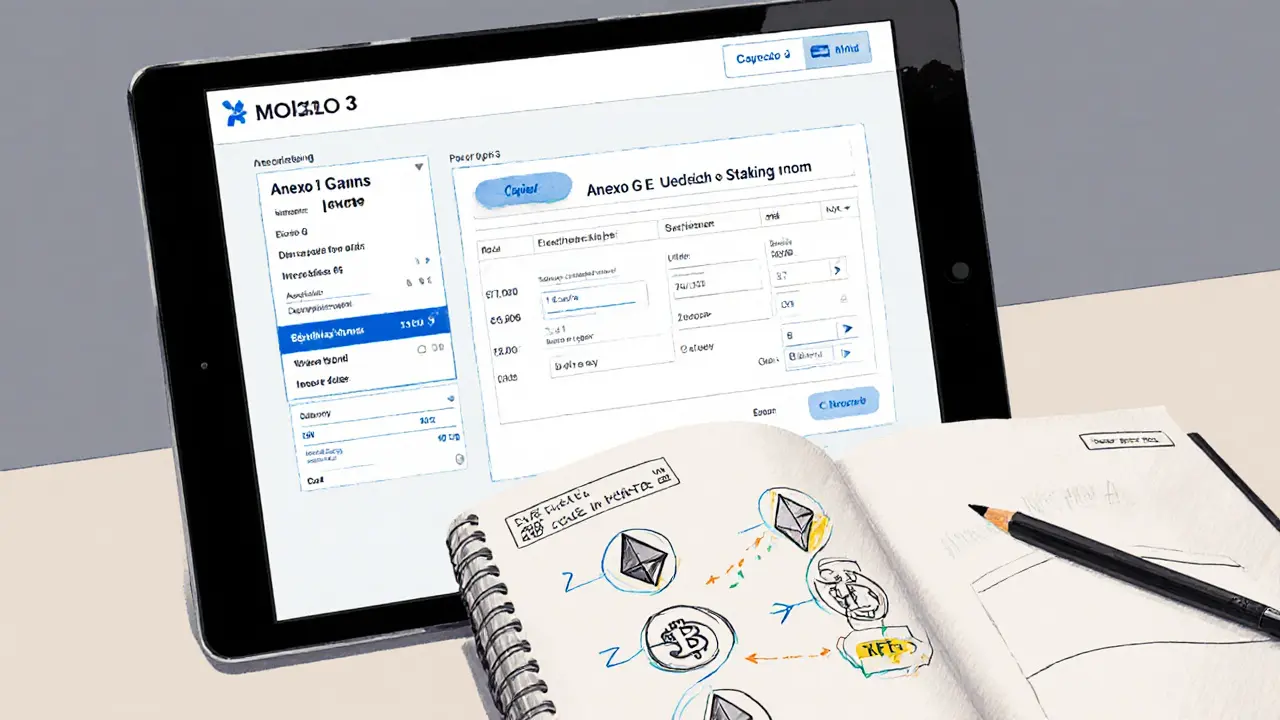Portugal Crypto Tax Calculator
Tax Calculation Results
Note: This calculator assumes you are a Portuguese tax resident and provides estimates only. Actual tax treatment may vary depending on your specific circumstances and should be confirmed with a tax advisor.
TL;DR
- Portugal taxes crypto gains held < 365 days at a flat 28% rate.
- Holding crypto > 1 year stays tax‑free for residents.
- You can opt for the flat rate or merge gains into your ordinary income.
- Reporting is done via Modelo 3 with Anexo G (capital gains) and Anexo E (staking).
- Long‑term investors and NHR beneficiaries still enjoy a very friendly regime.
Portugal used to be the go‑to spot for crypto traders who wanted zero tax. In 2023 the government introduced a 28% flat tax on short‑term crypto gains, but kept the 0% rate for assets held over a year. If you’re a resident, a digital nomad, or just curious about how the rules work, this guide shows you exactly what the 28% tax means, who it hits, and how to stay on the right side of the tax office.
Portugal short‑term cryptocurrency capital gains tax is a flat 28% levy applied to crypto profits realized within 365 days of acquisition. It replaced the previous blanket exemption for all crypto transactions and aligns Portugal with broader EU tax standards while preserving the country’s appeal for long‑term investors.
Who actually pays the 28% rate?
Any Portuguese tax resident who sells, swaps, or converts crypto before the 12‑month holding period ends is liable for the 28% flat tax. The rule covers:
- Crypto‑to‑fiat conversions (e.g., BTC → EUR).
- Crypto‑to‑crypto trades that result in a realized gain.
- Certain NFT transfers that are classified as disposable assets.
If you hold the same crypto for more than a year, the profit is exempt - no tax, no paperwork.
How the flat rate interacts with Portugal’s progressive income tax
Taxpayers have two choices:
- Apply the flat 28% rate directly to the short‑term gain.
- Include the gain in total annual income and let it be taxed under the progressive brackets.
The 2024 brackets look like this:
- 13.25% up to €7,703
- 18% €7,703‑€11,623
- 23% €11,623‑€16,472
- 26% €16,472‑€21,321
- 32.75% €21,321‑€27,146
- 37% €27,146‑€39,791
- 43.5% €39,791‑€51,997
- 45% €51,997‑€81,199
- 48% over €81,199
High‑income earners who push their total income above €81,199 will face 48% on the combined amount, which is higher than the flat 28%. For most people, the flat rate is the cheaper option.
Professional traders vs. hobby investors
If crypto trading is your main business, the tax authorities may label you a professional trader. Indicators include:
- High transaction volume (daily or weekly).
- Use of sophisticated strategies (margin, futures, algorithmic trading).
- Crypto activities represent the primary source of income.
Profits then count as business income and are taxed under the normal progressive rates (14.5%‑53%). The 28% flat rate does not apply to professional traders.
Reporting the tax - what forms you need
All crypto reporting goes through Portugal’s online portal, Portal das Finanças. The main return is Modelo 3, supplemented by:
- Anexo G - capital gains (short‑term vs. long‑term).
- Anexo E - passive income like staking or DeFi yields (also 28%).
- Anexo B - business income for professional traders.
Keep a spreadsheet that logs:
- Purchase date, amount, and EUR value at acquisition.
- Sale date, amount, and EUR value at disposal.
- Holding period calculation (days between purchase and sale).
- Any fees or transaction costs (they reduce the taxable gain).
Accurate records are crucial because the tax office can request supporting documentation for every entry.

Comparison with other EU jurisdictions
Portugal still scores well when you stack it against neighboring countries. Below is a quick snapshot:
| Country | Short‑Term Rate | Long‑Term Treatment | Notes |
|---|---|---|---|
| Portugal | 28% flat | 0% after 365 days | Flat rate optional; NHR can lower rates |
| Germany | Up to 45% (income tax) | 0% after 1 year for private use | Complex reporting for mixed use |
| France | 30% flat (incl. social levy) | 30% regardless of holding period | No holding‑period exemption |
| United Kingdom | Up to 20% CGT (higher‑rate taxpayers) | Same CGT rate, no exemption by time | Crypto may be treated as income |
| Spain | 19%‑28% (savings income) | Same rates, no time‑based exemption | Multiple brackets based on total gain |
Portugal’s 0% long‑term rule still makes it the most attractive spot for HODLers, even after the short‑term tax landed.
Impact on digital nomads and the NHR program
The Non‑Habitual Residence (NHR) offered a 10‑year window of reduced tax rates for newcomers. It closed to fresh applicants in January2024, but existing beneficiaries keep a 20% flat rate on Portuguese‑source income, which can be lower than the 28% crypto tax.
For a digital nomad who moved to Portugal before the cutoff, crypto gains sourced in Portugal might be taxed at 20% instead of 28%, provided the income is classified as Portuguese‑source. New residents after 2024 must follow the standard rules - the 28% flat rate for short‑term gains and 0% for long‑term.
Practical tips to minimise your crypto tax bill
- Plan the holding period. If you can wait 365 days before selling, you skip the tax entirely.
- Batch your trades. Consolidating multiple small sales into one larger sale after a year reduces administrative hassle.
- Leverage the flat‑rate option. For modest gains, the 28% flat rate is usually cheaper than adding the amount to a high income bracket.
- Track fees precisely. Exchange fees, network fees, and conversion costs lower your taxable profit.
- Consider NHR status. If you still qualify, the 20% flat rate may beat the 28%.
- Use crypto tax software. Tools like CoinLedger or Koinly can auto‑calculate holding periods across wallets and generate the required Anexo reports.
Staying organized throughout the year saves you from a scramble at tax time and lowers the chance of an audit.
What’s next for Portugal’s crypto tax framework?
Authorities are still polishing guidance on edge cases - forks, airdrops, and DeFi yield farming. The European Union’s Markets in Crypto‑Assets (MiCA) regulation, effective 2024, forces member states to improve reporting transparency, but it leaves tax rates up to each country. Expect clearer definitions of “professional trader” and possibly a slight tweaking of the 28% rate if other EU nations tighten their rules.
Lisbon’s crypto ecosystem continues to grow, with conferences, incubators, and a vibrant community of developers. That momentum suggests the tax regime will stay competitive, especially for long‑term investors who keep the 1‑year exemption.
Quick checklist before you file
- Identify every crypto transaction in the tax year.
- Calculate holding periods for each disposal.
- Separate short‑term gains (apply 28% or add to income).
- Fill Anexo G for capital gains and Anexo E for staking.
- Retain records for at least 5 years.
Frequently Asked Questions
Do I pay tax on crypto received as a gift?
A gift itself isn’t a taxable event, but when you later sell or trade the gifted crypto you must calculate the gain based on the donor’s original purchase price (the cost basis). If the holding period is under 365 days, the 28% flat rate applies.
How are staking rewards taxed?
Staking income is treated like other passive crypto income and is taxed at the flat 28% rate via Anexo E, unless you qualify as a professional trader, in which case it follows the progressive rates.
Can I combine short‑term gains with long‑term losses?
Yes. Net losses from long‑term disposals can offset short‑term gains, reducing the amount subject to the 28% tax. Make sure each loss is clearly documented.
What if I trade on multiple exchanges?
You must aggregate data from every platform. Most tax software can import CSV statements and calculate the overall holding period for each token across wallets.
Is the 28% rate subject to change?
The rate was set in the 2023 tax reform and is unlikely to shift dramatically unless the EU enforces new harmonisation rules. Keep an eye on official bulletins for any updates.

